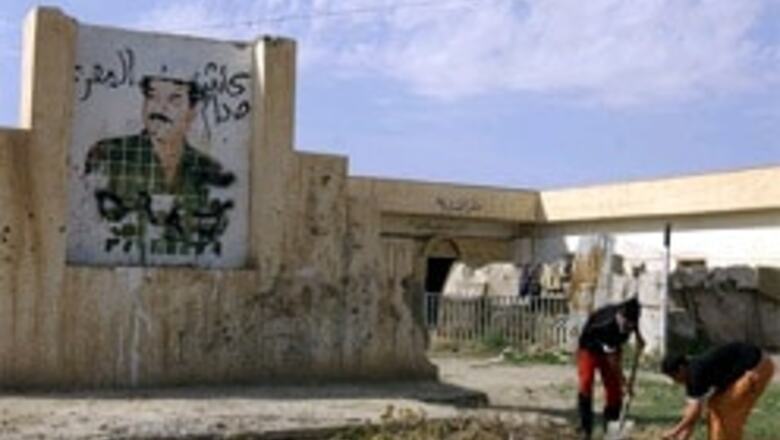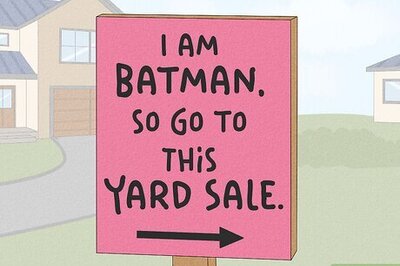
views
Former Iraqi President Saddam Hussein was found guilty of crimes against humanity and sentenced to death on Sunday for the killing of 148 Shi'ite men after a 1982 assassination attempt against him in the town of Dujail.
US soldiers captured Saddam in a raid on December 13, 2003. The once-defiant Iraqi leader was discovered, disheveled and unkempt, in an underground rudimentally ventilated "spider hole," about six-to-eight feet deep. The hole, its entrance camouflaged with bricks and dirt, was near a compound of ramshackle buildings about 9 miles outside Saddam's hometown of Tikrit.
Video taken of the 66-year-old Saddam during a medical examination after his capture showed him with a long, bushy, graying beard and matted hair. He did not resist when he was found and was uninjured, "talkative and cooperative," said Lt. General Ricardo Sanchez.
"He was a tired man," Sanchez said. "Also, I think, a man resigned to his fate."
The end of Saddam's rule began on March 19, when the US-led invasion of Iraqi opened with what the Pentagon called a "decapitation strike" – an unsuccessful airstrike aimed at killing the Iraqi leader.
Saddam said US troops would face a bloodbath in Iraq, but his regime fell in less than a month. Advancing US and British troops defaced and destroyed many of Saddam's monuments, followed later by ordinary Iraqis. Coalition forces now use many of the palaces he had built to glorify his rule as bases.
Once his regime fell, Saddam disappeared from public view and became the subject of an intense manhunt by US forces, who declared him No. 1 on the coalition's list of the 55 most-wanted members of his regime.
Saddam surfaced only in audiotapes released to Arab television networks in which a voice described as his urged Iraqis to continue to resist. In the last tape, released on November 16, the speaker told Iraqis to drive out the coalition troops with "jihad and resistance."
Insurgents in Iraq are fighting a low-intensity guerrilla war against coalition troops. Up till Saddam's capture, hit-and-run attacks with small arms, grenades and improvised bombs have killed more than 200 US and coalition troops since President Bush announced the end of major combat operations in Iraq on May 1.
PAGE_BREAK
A feared leader
For more than two decades, Iraqis were hard-pressed to escape Saddam's gaze. On the streets of Baghdad, on monuments and buildings throughout the country, his image was everywhere. Crowds cheered his every action and decree, and thousands voiced support for his policies.
Yet despite his nearly omnipresent images before the war, the Iraqi leader was rarely seen in public, taking extreme measures to shield himself from his many enemies and to carefully craft his image.
Opposition leaders based outside of Iraq, as well as US officials, insist that his public support was a facade, a function of most Iraqis' fear about what would happen to them if they were to speak or act against Saddam.
An entrenched system of paranoia dominated pre-war Iraq, they contend, led by secret police charged with protecting Saddam and preserving his power. Western, Arab and Iraqi sources portrayed Saddam as a man replete with contradictions: progressive and intolerant, politically savvy and maliciously brutal, supremely powerful and personally insecure.
"He sees himself as the figure whose name will be revered hundreds of years from now in Arab culture and Arab history," says Mark Bowden, a best-selling author and columnist for The Philadelphia Inquirer.
Saddam appeared to have a firm grip on power in Iraq before the US-led invasion, having overcome military setbacks against Iran in the 1980s and the US-led forces in 1991 during the Persian Gulf War. He also survived a rash of assassination attempts and years of devastating sanctions imposed by the UN after the Persian Gulf War.
He spent much of 2002 staring down a familiar enemy: the US. In a speech in Cincinnati, Ohio, in October 2002, Bush quoted a former chief weapons inspector calling Saddam "a homicidal dictator who is addicted to weapons of mass destruction."
Yet Saddam did not back down from Bush's threats and insistence he give up power in Iraq. In early March 2003, Saddam issued a statement to the Iraqi press saying, "It is without doubt that the faithful will be victorious against aggression and against all things, against those who are faithful."
Although the Saddam Hussein regime is gone, coalition forces are still searching for weapons of mass destruction.
PAGE_BREAK
From peasantry to power
Saddam was born April 28, 1937, in a rural town outside Tikrit, 100 miles north of Baghdad, into "a very poor family, only one notch above the very bottom of Iraqi social life," says Amatzia Baram, an authority on Iraq and Middle Eastern history based in Haifa, Israel.
Saddam grew up without his biological father. His mother's brother (and Saddam's future father-in-law), Khairallah Talfah, an Iraqi army officer and Arab nationalist, served as a major influence in his early years.
Having moved to Baghdad as a teenager, Saddam joined the Arab Baath Socialist Party and initially dedicated to secularism, socialism and pan-Arab unionism, as a secondary school student.
In 1958, he spent six months in prison for his political activities.
The next year, Saddam and several others attempted to assassinate General Abdul Karim Kassem, who came to power in 1958 in a military coup. Saddam was shot in the leg during the botched attempt, but he escaped and fled Iraq. He was sentenced to death in absentia February 25, 1960, for his role in the assassination plot.
After studying in Egypt, Saddam returned to Iraq in February 1963 after the "Ramadan Revolution," when Baath Party members overthrew Kassem. But months of political turmoil culminated in another coup, and Saddam was arrested again October 14, 1964.
According to the pre-war Iraqi News Agency, Saddam escaped from jail in 1967. In July 1968, he played a leading role in a coup that led to the ascension of Ahmed Hassan al-Bakr, a fellow Baath member and Saddam's cousin, as Iraq's new ruler.
As vice chairman of the Revolutionary Command Council – in effect, al-Bakr's second-in-command – Saddam promoted many progressive ideas in the late 1960s and early 1970s.
"Saddam accumulated power over a period of 10-12 years," Bowden says. "When you've evidenced considerable charm [and] an ability to get things done, even very idealistic and ambitious people begin to side with you."
PAGE_BREAK
Executions and chemical weapons
That charm was hard to detect when al-Bakr stepped down – officially, due to illness – and Saddam took over as president in 1979.
With a camera recording the event, Saddam told a room full of leading officials that he had uncovered a conspiracy to overthrow the government and, one-by-one, named the alleged traitors. Sixty-eight men were taken away, and 21 summarily executed.
"He essentially betrayed many of those people who had relied on him," Bowden says.
In 1980, he entered a war with Iran that lasted eight years. While casualty counts on both sides vary greatly, some estimates indicate the war cost more than a million lives before ending in a stalemate.
The UN alleged that Saddam ordered Iraqi forces to use mustard gas and nerve agents on Iranian soldiers, and that he unleashed chemical weapons on rebellious Kurds in northern Iraq in 1988.
That same year, Saddam's personal life made headlines when his eldest son, Uday, killed one of his father's top aides. After a brief exile in Switzerland, Uday returned to Iraq, where he developed a reputation for eccentric antics, including designing clothing to match his Mercedes, bringing women from other countries into Iraq for sex and shooting guns at his many wild parties, Bowden says.
Two of Saddam's sons-in-law defected from Iraq in 1995, telling Western authorities that the Iraqi government had concealed evidence of its chemical, biological and nuclear weapons programs.
Lured back to Iraq by promises of leniency, Saddam's sons-in-law were shot upon their return.
A year later, would-be assassins shot Uday, partially paralyzing him from the waist down. When asked by CNN while he lay in the hospital about his succeeding his father, Uday replied, "If that was not a question from you, a foreigner, the person who spoke like this would be questioned or punished."
That responsibility, experts say, fell to Saddam's other son, Qusay, who was reportedly being groomed by his father to some day assume control of Iraq. Saddam and his wife Sajida, his first cousin, also had three daughters.
"Qusay [was] reputed to be a far quieter, more disciplined figure [than Uday]," Bowden says.
Any chance of someday filling their father's shoes ended July 22, 2003, when US soldiers killed Uday and Qusay in a raid on a villa in the northern city of Mosul.
Hoping to reassure Iraqis that the brothers were dead, the Pentagon allowed journalists to shoot still photographs and video of their bodies. The images were broadcast worldwide.
PAGE_BREAK
Obsessed with image, hygiene, security
As his powers increased, so did Saddam's quirks and fixations, according to several men who have studied him.
The Iraqi ruler's speeches were printed in large letters so he did not have to wear glasses – and be seen as less than perfect – in public, Bowden says. Saddam also forbade journalists from videotaping him walking any distance, Bowden adds, so no one would see footage of his pronounced limp.
His contempt for US policies notwithstanding, Saddam enjoyed watching American movies, particularly "spy thrillers where the hero is pitted against ... an unscrupulous government," Bowden says. His favorites included the Oscar-winning "The Godfather," and "The Old Man and the Sea," based on a novel by one of his favorite US authors, Ernest Hemingway.
A voracious reader, Saddam is said to have penned romantic or fantasy novels. The dictator also wrote a copy of the Quran in his own blood, according to the Iraqi media, which reported that Saddam was descended from Muhammad, the prophet of Islam.
Saddam's fear of assassination prompted him to take several extreme measures. He slept just four or five hours a night, always in secret locations, Bowden says.
Not only was all of his food carefully prepared and inspected, but the chefs in each of his more than 20 palaces also cooked three elaborate meals a day - whether Saddam was to eat there or not.
"In order to make it more difficult for people to tell exactly where he [was], all the palaces [functioned] as though [he were] present," Bowden says.
PAGE_BREAK
'A big-time gambler'
Whatever his fears and challenges, Saddam showed defiance, obstinacy and a propensity to take risks ever since coming on the Iraqi political scene in the late 1950s.
"He's a big-time gambler," Baram says. "He cannot help himself. He is hooked on it."
That boldness was evidenced in 1990, when Saddam – his nation's economy in shambles -- ordered troops and tanks to roll into Iraq's oil-rich neighbor to the south, Kuwait. In 1991, a UN-backed, US-led military coalition routed Iraq's forces and forced them out of Kuwait in the Gulf War.
But just like the end of Iraq's stalemate with Iran three years earlier, Saddam declared victory. His resume, which was posted on the Web site of Iraq's UN mission, claimed Saddam led Iraq in confronting "the aggression launched by 33 countries led by the US Iraq stood strong against the invasion, maintaining its sovereignty and political system."
During the 1990s, Saddam, the UN and Western powers went back and forth on sanctions, airstrikes and particularly Iraq's alleged chemical, biological and nuclear program. Charles Duelfer, a top official with the UN Special Commission on Iraq from 1993 until it was disbanded in 2000, said Iraq hindered the effort more than it helped, misleading inspectors and refusing access to sensitive buildings.
"It was a great game," Duelfer said.
In the years before the 2003 war, Washington accused Saddam of profiting from illicit oil sales, developing weapons of mass destruction and brutally controlling his countrymen. Iraq's former Deputy Prime Minister, Tariq Aziz, said October 1, 2002, "the things that Washington says are all untrue."
Coalition forces have yet to find any weapons of mass destruction despite an intensive search.
The use of intelligence by both the Bush administration and British Prime Minister Tony Blair to make the case for war have become political issues in both countries, with opponents of both governments claiming that Bush and Blair overstated the threat posed by Saddam's regime.
But since the US invasion, hundreds of mass graves have been uncovered in Iraq, evidence of the brutal methods that Saddam employed to maintain his grip on power.

















Comments
0 comment